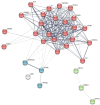This is a preprint.
Assessing Inflammatory Protein Biomarkers in COPD Subjects with and without Alpha-1 Antitrypsin Deficiency
- PMID: 39867385
- PMCID: PMC11759610
- DOI: 10.1101/2025.01.11.25320392
Assessing Inflammatory Protein Biomarkers in COPD Subjects with and without Alpha-1 Antitrypsin Deficiency
Update in
-
Assessing inflammatory protein biomarkers in COPD subjects with and without alpha-1 antitrypsin deficiency.Respir Res. 2025 Jul 15;26(1):247. doi: 10.1186/s12931-025-03320-8. Respir Res. 2025. PMID: 40665347 Free PMC article.
Abstract
Rationale: Individuals homozygous for the Alpha-1 Antitrypsin (AAT) Z allele (Pi*ZZ) exhibit heterogeneity in COPD risk. COPD occurrence in non-smokers with AAT deficiency (AATD) suggests inflammatory processes may contribute to COPD risk independently of smoking. We hypothesized that inflammatory protein biomarkers in non-AATD COPD are associated with moderate-to-severe COPD in AATD individuals, after accounting for clinical factors.
Methods: Participants from the COPDGene (Pi*MM) and AAT Genetic Modifier Study (Pi*ZZ) were included. Proteins associated with FEV1/FVC were identified, adjusting for confounders and familial relatedness. Lung-specific protein-protein interaction (PPI) networks were constructed. Proteins associated with AAT augmentation therapy were identified, and drug repurposing analyses performed. A protein risk score (protRS) was developed in COPDGene and validated in AAT GMS using AUC analysis. Machine learning ranked proteomic predictors, adjusting for age, sex, and smoking history.
Results: Among 4,446 Pi*MM and 352 Pi*ZZ individuals, sixteen blood proteins were associated with airflow obstruction, fourteen of which were highly expressed in lung. PPI networks implicated regulation of immune system function, cytokine and interleukin signaling, and matrix metalloproteinases. Eleven proteins, including IL4R, were linked to augmentation therapy. Drug repurposing identified antibiotics, thyroid medications, hormone therapies, and antihistamines as potential AATD treatments. Adding protRS improved COPD prediction in AAT GMS (AUC 0.86 vs. 0.80, p = 0.0001). AGER was the top-ranked protein predictor of COPD.
Conclusions: Sixteen proteins are associated with COPD and inflammatory processes that predict airflow obstruction in AATD after accounting for age and smoking. Immune activation and inflammation are modulators of COPD risk in AATD.
Figures




References
-
- Silverman E. K. & Sandhaus R. A. Clinical practice. Alpha1-antitrypsin deficiency. The New England journal of medicine 360, 2749–57 (2009). - PubMed
Publication types
Grants and funding
LinkOut - more resources
Full Text Sources
Research Materials
Miscellaneous
